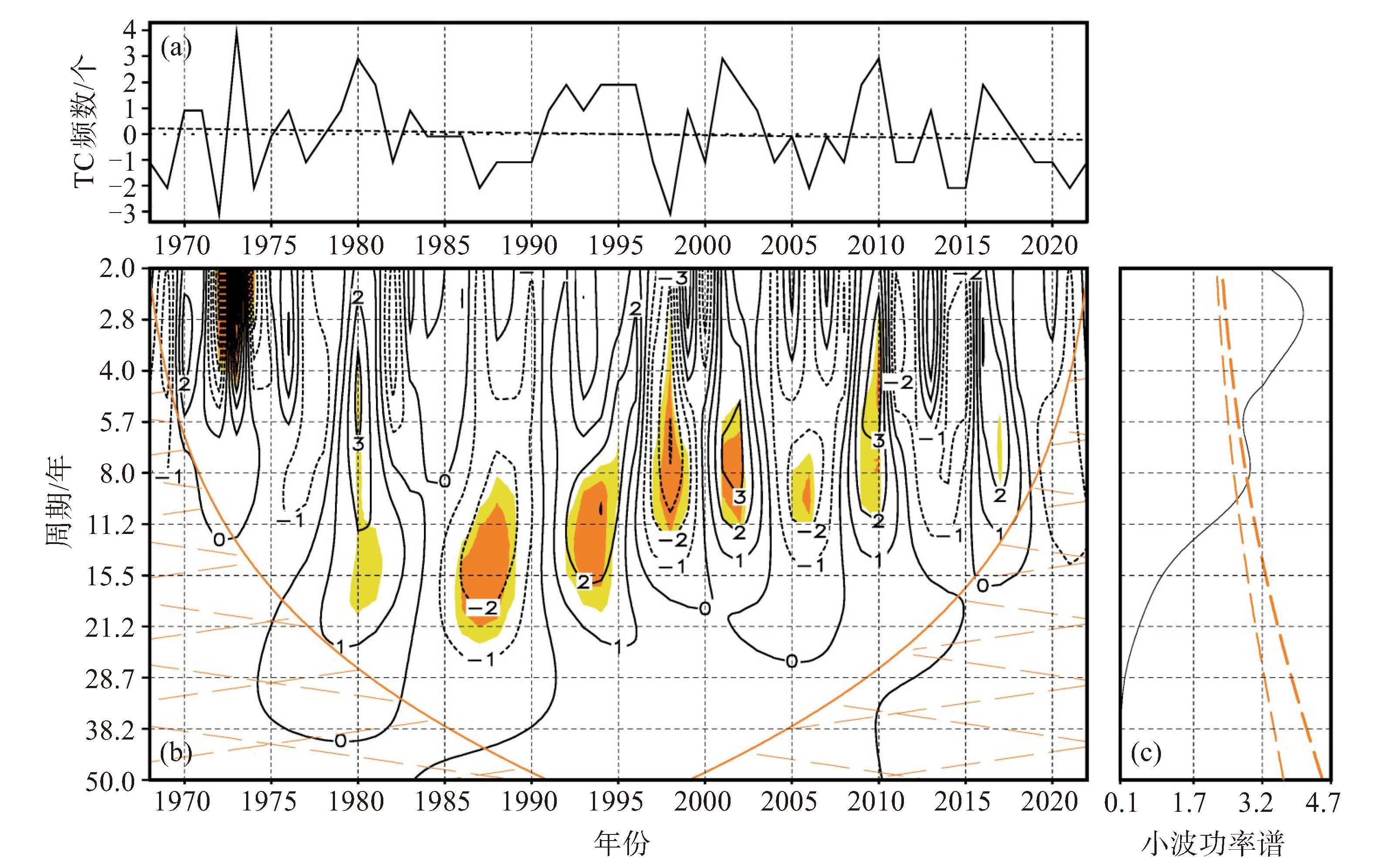Interannual Bimodal Variability of Tropical Cyclones Landing in Guangdong and Their Asymmetric Relationship with Sea Surface Temperature
-
摘要: 基于1968—2022年后汛期登陆广东热带气旋(TC)频数、再分析资料和海温数据,采用小波分析、合成分析等方法,探讨了登陆广东TC频次的年际变化特征,重点揭示了其年际变率中存在的双模态特征及其与海表温度的非对称关系。(1)登陆广东TC频数存在显著的准3年和准8年双模态周期振荡,两者变化幅度相当。(2)不同模态下,影响TC登陆的大气环流配置存在显著差异。在两个模态的登陆广东TC频数异常偏多年,西太平洋副热带高压(简称“副高”)皆表现为偏西偏强,有利于TC登陆广东。而在TC频数异常偏少年,两种模态对应的副高形势明显不同:准3年模态下的副高偏弱偏东,易导致TC过早北上;准8年尺度上副高偏西偏强,但其南侧的显著异常东风引导TC西行。(3)登陆广东热带气旋频数与海表温度的关系呈非对称性。在准3年时间尺度上,登陆广东TC频数偏多年冬季SST主要显著正距平出现在赤道东太平洋和热带北印度洋至南海。在准8年时间尺度上,登陆广东TC频数偏多年冬季SST主要显著正距平出现在赤道中太平洋;而频数偏少年冬季热带印度洋SST整体异常偏高。从冬季厄尔尼诺事件向夏季拉尼娜事件转换的年份,登陆广东TC频数偏多。本研究有助于加深对登陆广东TC变化特征的认识,其与海表温度关系的非对称性对做好登陆广东热带气旋频数的短期气候预测有一定指导意义。Abstract: This study investigates the interannual variability of landfalling tropical cyclones (TCs) in Guangdong during the post-flood season (1968-2022), using TC frequency data, reanalysis products, and sea surface temperature (SST) data. Through wavelet and composite analysis, we specifically explore the prominent bimodal characteristics in their interannual variability and their asymmetric relationship with SST. The main findings are as follows: (1) The frequency of landfalling TCs in Guangdong exhibits significant quasi-3-year and quasi-8-year bimodal periodic oscillations, with comparable amplitudes. (2) Under different modes, significant variations exist in atmospheric circulation configurations that influence TC landfalls. During years with more landfalling TCs for both quasi-3-year and quasi-8-year timescales, the Western Pacific Subtropical High (WPSH) shifts westward and strengthens, facilitating TC landfalls in Guangdong. Conversely, the WPSH configurations during less landfalling TC years are distinct for each mode. On the quasi-biennial timescale, the WPSH is weaker and retreats eastward, causing TCs to recurve northward prematurely; however, on the quasi-3-year timescale, the WPSH remains westward and strong, with significant anomalous easterlies on its southern flank that guide TCs westward. (3) The relationship between the landfalling TC frequency in Guangdong and SST is asymmetric. On the quasi-3-year timescale, years with more landfalling TCs are associated with significant positive winter SST anomalies in the equatorial eastern Pacific and from the tropical North Indian Ocean to the South China Sea (SCS). On the quasi-8-year timescale, more TC landfall years correspond to significant positive winter SST anomalies mainly in the equatorial central Pacific, while less TC landfall years generally exhibit positive winter SST anomalies across the entire tropical Indian Ocean. In addition, landfalling TC frequency tends to be higher in transition years from winter El Niño to summer La Niña conditions. This study enhances our understanding of the variability characteristics of landfalling TCs in Guangdong, and the identified asymmetric relationship with SST provides valuable guidance for improving short-term climate predictions of landfalling TC frequency in this region.
-
图 7 同图 6,选取时间段为7—9月
-
[1] 金蕊, 余晖, 吴志伟, 等. 次季节-季节尺度热带气旋活动研究和预测技术进展[J]. 大气科学学报, 2020, 43(1): 238-254. [2] TORRALBA V, DOBLAS-REYES F J, MACLEOD D, et al. Seasonal climate prediction: a new source of information for the management of wind energy resources[J]. J Appl Meteor Climatol, 2017, 56(5): 1 231-1 247. [3] CAMARGO S J, BARNSTON A G, KLOTZBACH P J, et al. Seasonal tropical cyclone forecasts[J]. WMO Bull, 2007, 56(4): 297-309. [4] LIANG Z, WU L, ZONG H. Increasing threat of landfalling tropical cyclones in China since the late 1970s[J]. Nat Commun, 2021, 12(1): 1-9. [5] WANG C, WU L, ZHAO H. Re-examining the tropical cyclone genesis potential index over the western North Pacific[J]. J Climate, 2018, 31(14): 5 501-5 517. [6] ZHOU Y, YANG L, LI K. Bimodal distribution of tropical cyclone landfalls in Guangdong: Observational evidence and possible mechanisms[J]. Atmos Res, 2020, 245: 105073. [7] HU C, YANG S, WU R. Non-linear impacts of sea surface temperature anomalies on tropical cyclone genesis over the western North Pacific [J]. Geophys Res Lett, 2022, 49(8): e2021GL097234. [8] CAMARGO S J, EMANUEL K A, SOBEL A H. Use of a genesis potential index to diagnose ENSO effects on tropical cyclone genesis[J]. J Climate, 2007, 20(19): 4 819-4 834. [9] LI X, ZHOU W. Interdecadal changes in summertime tropical cyclone genesis over the South China Sea and western North Pacific[J]. Clim Dyn, 2015, 45(11-12): 3 233-3 246. [10] GUO Y, REN F, WANG X. Bimodal variation of tropical cyclone landfall frequency in South China and its association with Pacific Decadal Oscillation[J]. Adv Atmos Sci, 2021, 38(5): 789-802. [11] CHEN G, HUANG R, ZHOU W. Relative roles of dynamic and thermodynamic effects in the anomalous western North Pacific tropical cyclone genesis frequency during El Niño[J]. J Climate, 2019, 32(9): 2 765-2 783. [12] HUANG B, WANG L, CHEN J. Interannual variability of tropical cyclone landfall in Guangdong: The role of western Pacific subtropical high[J]. J Trop Meteor, 2018, 24(3): 241-254. [13] WU Q, ZHANG H, LIU C. Modulation of vertical wind shear on tropical cyclone intensity over the South China Sea[J]. J Geophys Res Atmos, 2020, 125(15): e2020JD032723. [14] FENG X, LI T, HSU P C. Asymmetric impacts of El Niño and La Niña on the western North Pacific tropical cyclone activity[J]. Clim Dyn, 2022, 58(3-4): 927-941. [15] 伍红雨, 吴遥, 张柳红. 7—9月登陆华南热带气旋频数异常与大气环流和海温的关系[J]. 热带气象学报, 2024, 40(2): 169-177. [16] EMANUEL K, NOLAN D S. Tropical cyclone activity and the global climate system[C]//26th Conference on Hurricanes and Tropical Meteorology. Miami: American Meteorological Society, 2004: 240-241. [17] ZHANG X, LI T, WANG C. Local SST cooling in the South China Sea modulates tropical cyclone activity over the western North Pacific [J]. J Climate, 2021, 34(10): 1 234-1 245. [18] YING M, ZHANG W, YU H. Asymmetric impacts of Indian Ocean Dipole on tropical cyclone landfall in South China[J]. J Climate, 2023, 36(2): 511-525. [19] KALNAY E, KANAMITSU M, KISTLER R, et al. The NCEP/NCAR 40-year reanalysis project[J]. Bull Amer Meteor Soc, 1996, 77(3): 437-471. [20] HUANG B, BANZON V F, FREEMAN E, et al. Extended reconstructed sea surface temperature version 5 (ERSSTv5): Upgrades, validations, and intercomparisons[J]. J Climate, 2017, 30(1): 8 179-8 205. [21] 谢炯光, 纪忠萍. 登陆广东省热带气旋的奇异谱分析[J]. 热带气象学报, 2003, 19(2): 163-168. [22] YING M, ZHANG W, YU H, et al. An overview of the China Meteorological Administration tropical cyclone database[J]. J Atmos Oceanic Technol, 2014, 31(2): 287-301. [23] LU X Q, YU H, YING M, et al. Western North Pacific tropical cyclone database created by the China Meteorological Administration[J]. Adv Atmos Sci, 2021, 38(4): 690-699. [24] LAU K M, WENG H Y. Climate signal detection using wavelet transform: How to make a time series sing[J]. Bull Amer Meteor Soc, 1995, 76(12): 2 391-2 402. [25] TORRENCE C, COMPO G P. A practical guide to wavelet analysis[J]. Bull Amer Meteor Soc, 1998, 79(1): 61-78. [26] 谷德军, 王东晓, 纪忠萍, 等. 墨西哥帽小波变换的影响域和计算方案新探讨[J]. 应用气象学报, 2009, 20(1): 62-69. [27] DUCHON C E. Lanczos filtering in one and two dimensions[J]. J Appl Meteor, 1979, 18(8): 1 016-1 022. [26] MURAKAMI T. Intraseasonal atmospheric teleconnection patterns during the Northern Hemisphere summer[J]. Mon Wea Rev, 1987, 115(9): 2 133-2 154. [27] BRETHERTON C S, WIDMANN M, DYMNIKOV V P, et al. The effective number of degrees of freedom of a time-dependent global average[J]. J Climate, 1999, 12(7): 1 990-2 009. [29] ZWIERS F W, von STORCH H. Taking serial correlation into account in tests of the mean[J]. J Climate, 1995, 8(2): 336-351. [30] YANG S, LAU K M, KIM K M. Variations of the East Asian jet stream and Asian-Pacific-American winter climate anomalies[J]. J Climate, 2002, 15(3): 306-325. [31] 吴国雄. 海温异常对台风形成的影响[J]. 大气科学, 1992, 16(3): 322-332. [32] GILL A E. Some simple solutions for heat-induced tropical circulation[J]. Quart J Roy Meteor Soc, 1980, 106(449): 447-462. -






 下载:
下载:








 粤公网安备 4401069904700003号
粤公网安备 4401069904700003号